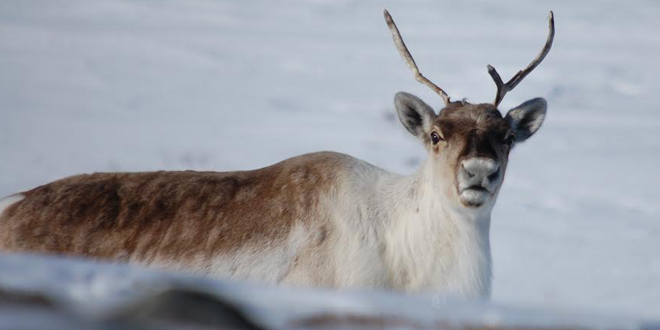
By Bjorn Dihle
The origin of the word “caribou” comes from Newfoundland’s Micmac First Nation clan, the Yalipu. Yalipu roughly translates as “snow-shoveler”—caribou shovel through the snow with their sharp hooves to access lichens and other vegetation.
I’ve been fascinated with caribou and the wild country they live in since an early age. My idea of the perfect vacation is wandering around caribou country, hoping to tag along on a migration. I took it as a good omen when my little brother married a Newfoundlander who happens to be a member of the Yalipu clan. I suggested they honeymoon in the Arctic, perhaps following the Porcupine herd migrating from their winter grounds in the Yukon to their calving grounds in Alaska, but they elected to go to Hawaii instead.
Caribou around the world face an uncertain future with climate change and human encroachment. Warmer winters in the Arctic lead to more freezing rain and melt/thaw events which leads to more iced over snow-packs. When this happens, caribou and other ungulates have difficulty digging through the ice-pack to feed on lichens and other vegetation. Warmer summers lead to more mosquitoes and other biting insects, which can stress and weaken animals. Oil, mining and other industrial development in the Arctic pose an increasing threat to migration routes and calving grounds.
Most herds being studied show population declines that have biologists and locals concerned. So for some it came as surprise that on March 14th 2014, the Canadian Press reported that the Porcupine herd has risen to an estimated 197,000 animals. This is up from a count made in 2001 estimating the herd at 123,000. The Porcupine herd most often winters in the taiga of northern Yukon and the Northwest Territory. Late each spring, led by pregnant cows and yearlings, the herd migrates, most often, to Arctic National Wildlife Refuge’s (ANWR) coastal plain along the Beaufort Sea coast to calve.
ANWR, a 19.6 million acre swath of mountains, valleys and tundra, was designated a refuge in 1960. Pockets of oil were discovered soon after, and it’s been a political battleground ever since. Ninety five percent of Alaska’s Arctic coastal plane is opened to be leased and developed by oil companies. The remaining five percent, the entire coastal plain in ANWR and the calving grounds of the Porcupine Caribou herd, can only be opened for development by Congress.
Yukon hunters witnessing dramatic declines in other Canadian caribou herds are making a strong effort to assure the health of the Porcupine herd for future generations. They’re conducting their hunts in ways that minimize negative effects on populations, such as targeting bulls and passing on cows.
Joe Tetlichi, Chairman of Canada’s Porcupine Management Board, was reported saying in the Canadian Press: “We have no control over weather, we have no control over climate change, we have no control over global warming. What we do have control over is how we harvest.”
Caribou in Alaska seem to be slightly more stable than Canada, excluding the rapid decline of the Western Arctic Herd. In 2003 the herd peaked at nearly half a million—by far the largest herd in Alaska. Now it’s estimated around 300,000 and still declining. Jim Dau, a biologist with the Alaska Department of Fish and Game (ADF&G) who’s studied the Western Arctic herd for 25 years, stated in a recent interview with Smithsonian Magazine that he guessed the decline was largely due to having “more rain on snow events than we used to.” Dau went on to say that the rain has “created icing conditions that seal the food.” Caribou are unable to break through the ice crust. He’s also noticed what appears to be an increase in wolves and brown bears.
Whether or not the Western Arctic Herd is following in the hoof-steps of the Mulchatna herd—the Southwest herd peaked to around 200,000 in the 1990s before plummeting to a mere fraction of that—or will stabilize remains to be seen.
ADF&G recognizes 32 different herds in Alaska, distinguished by the different calving grounds herds utilize. Right now ADF&G estimates our state’s caribou population at 750,000, including herds that travel back and forth from Alaska to Canada.
Writing about caribou has got me nostalgic for the times I was lucky enough to spend with different herds. One of the most powerful experiences I’ve had with wildlife was walking for two weeks with the Western Arctic Herd. Each day the mountains and valleys of the Brooks Range were filled with anywhere from hundreds to thousands of caribou. Someday soon I hope to return to the Arctic and, if I’m lucky, enjoy the company of caribou.
